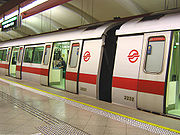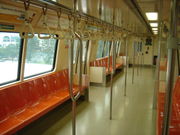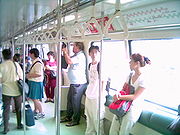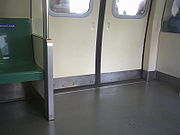
Siemens C651 Cars
Encyclopedia
Siemens
C651 Cars form a type of rolling stock
that can be found on the North South Line
and East West Line
of the Mass Rapid Transit
system in Singapore
, operated by SMRT Trains
. A total of 114 cars were purchased and introduced from 1994 onwards. This is the only white (in other terms, unrefurbished) train that is used on the SMRT North South Line
and the East West Line
.
 Operating on the North South Line
Operating on the North South Line
and the East West Line
since the mid 1990s, the Siemens C651 trains are the second generation of the four types of train cars used on the SMRT network. They were bought mainly to complement the existing Kawasaki C151 trains due to the opening of the Woodlands extension. Unlike its older counterparts, the C651s are painted with a scratch-resistant acrylic finish due to dirt trapping on the aluminum skin of the C151s that were difficult to remove.
These cars come with green-blue tinted glass windows. They look almost identical to the first generation train cars before its refurbishment, except that its traction produces a louder, lower-pitched noise when accelerating/braking. The run number display on the front of each train is made up of electronic green flip-dot
display, as opposed to the manual plastic rollers of the Kawasaki C151 trains, while the rubber strips between the doors are thicker. The trains have a full white body and a thick red stripe in the middle. 19 trainsets of 6 cars each were purchased, the first rolling out of the SGP plant on 17 July 1994 with much fanfare and delivered to SMRT on 20 September 1994. Similar to the Kawasaki Heavy Industries C151 trains, the Siemens C651 trains have no visual passenger information systems, but have a built-in audio announcement system until the STARIS system was installed and activated around 2010.


 Many experimental programmes have been run on the C651 cars.
Many experimental programmes have been run on the C651 cars.
Some trains of this type were reconfigured to have more standing space in the late 1990s as part of an experimental programme. In particular, the second and fifth cars (the blue
cars) were reconfigured to have more standing room at the door sides, after it was found that standing passengers liked to stand at the sides of the doors. The reconfigured layout allowed two passengers to stand in the same space, although this space was "shrunk" to one passenger only in the layout of later trains. This is the train which was the oldest interior.
The third and fourth cars, coloured in green
were even more radical in the reconfiguration, with all but eight seats, four at each ends of the car removed completely. In its place was standing room with upholstered cushion
, in an attempt to provide a degree of comfort to passengers standing in that space. This design proved to be unpopular with the commuters, and it was eventually dropped. Only carriages 2209 and 2210 are seen to feature these upholstered cushions at the centre of these two cars. The original seats between the 1st and 2nd door, and the 3rd and 4th door on these cars have been replaced. The remaining upholstered seats were replaced in May 2006. 10 trains from refurbished C151 made this standard, and only 14 seats from each car were therefore removed.
More grabpoles were also added. Regular grabpoles in the centre of each car were replaced by grabpoles that branch out into three in the centre, similar in purpose to those on the C151 and C751B cars. In 2011, extra grabpoles were installed on a trial basis. SMRT is also testing special non slip floorings.
In 2006, SMRT began installing CCTVs
into some of the train cars, which would enable the Central Control Room to monitor activities in the train, when the need arises. These are part of measures to beef up security on Singapore's public transport network, and to deter vandalism and terrorism.
(ATC), supplemented with Automatic train operation
(ATO). At a fallback level, Automatic Train Protection
(ATP) is available.
Siemens
Siemens may refer toSiemens, a German family name carried by generations of telecommunications industrialists, including:* Werner von Siemens , inventor, founder of Siemens AG...
C651 Cars form a type of rolling stock
Rolling stock
Rolling stock comprises all the vehicles that move on a railway. It usually includes both powered and unpowered vehicles, for example locomotives, railroad cars, coaches and wagons...
that can be found on the North South Line
North South MRT Line
The North South Line was the 1st Mass Rapid Transit line in Singapore. The line is currently 44 km long with 25 stations, and is operated by SMRT Corporation...
and East West Line
East West MRT Line
The East West Line was the 2nd Mass Rapid Transit line in Singapore. The line is currently 49.2 km long with 35 stations , making it the longest MRT line in Singapore. It takes about 63 minutes to travel from one end to the other...
of the Mass Rapid Transit
Mass Rapid Transit (Singapore)
The Mass Rapid Transit or MRT is a rapid transit system that forms the backbone of the railway system in Singapore, spanning the entire city-state. The initial section of the MRT, between Yio Chu Kang Station and Toa Payoh Station, opened in 1987 establishing itself as the second-oldest metro...
system in Singapore
Singapore
Singapore , officially the Republic of Singapore, is a Southeast Asian city-state off the southern tip of the Malay Peninsula, north of the equator. An island country made up of 63 islands, it is separated from Malaysia by the Straits of Johor to its north and from Indonesia's Riau Islands by the...
, operated by SMRT Trains
SMRT Trains
SMRT Trains Limited is a rail operator in Singapore and a wholly owned subsidiary of SMRT Corporation. Then known as Mass Rapid Transit Corporation when it was incorporated on 6 August 1987, it was renamed as Singapore MRT Limited before taking on its current name, SMRT Trains, in the year...
. A total of 114 cars were purchased and introduced from 1994 onwards. This is the only white (in other terms, unrefurbished) train that is used on the SMRT North South Line
North South MRT Line
The North South Line was the 1st Mass Rapid Transit line in Singapore. The line is currently 44 km long with 25 stations, and is operated by SMRT Corporation...
and the East West Line
East West MRT Line
The East West Line was the 2nd Mass Rapid Transit line in Singapore. The line is currently 49.2 km long with 35 stations , making it the longest MRT line in Singapore. It takes about 63 minutes to travel from one end to the other...
.
Overview

North South MRT Line
The North South Line was the 1st Mass Rapid Transit line in Singapore. The line is currently 44 km long with 25 stations, and is operated by SMRT Corporation...
and the East West Line
East West MRT Line
The East West Line was the 2nd Mass Rapid Transit line in Singapore. The line is currently 49.2 km long with 35 stations , making it the longest MRT line in Singapore. It takes about 63 minutes to travel from one end to the other...
since the mid 1990s, the Siemens C651 trains are the second generation of the four types of train cars used on the SMRT network. They were bought mainly to complement the existing Kawasaki C151 trains due to the opening of the Woodlands extension. Unlike its older counterparts, the C651s are painted with a scratch-resistant acrylic finish due to dirt trapping on the aluminum skin of the C151s that were difficult to remove.
These cars come with green-blue tinted glass windows. They look almost identical to the first generation train cars before its refurbishment, except that its traction produces a louder, lower-pitched noise when accelerating/braking. The run number display on the front of each train is made up of electronic green flip-dot
Flip-disc display
The flip-disc display is an electromechanical dot matrix display technology used for large outdoor signs, normally those that will be exposed to direct sunlight. Flip-disc technology has been used on buses across North America and Europe. It has also been used extensively on public information...
display, as opposed to the manual plastic rollers of the Kawasaki C151 trains, while the rubber strips between the doors are thicker. The trains have a full white body and a thick red stripe in the middle. 19 trainsets of 6 cars each were purchased, the first rolling out of the SGP plant on 17 July 1994 with much fanfare and delivered to SMRT on 20 September 1994. Similar to the Kawasaki Heavy Industries C151 trains, the Siemens C651 trains have no visual passenger information systems, but have a built-in audio announcement system until the STARIS system was installed and activated around 2010.
Experimental programmes



Some trains of this type were reconfigured to have more standing space in the late 1990s as part of an experimental programme. In particular, the second and fifth cars (the blue
Blue
Blue is a colour, the perception of which is evoked by light having a spectrum dominated by energy with a wavelength of roughly 440–490 nm. It is considered one of the additive primary colours. On the HSV Colour Wheel, the complement of blue is yellow; that is, a colour corresponding to an equal...
cars) were reconfigured to have more standing room at the door sides, after it was found that standing passengers liked to stand at the sides of the doors. The reconfigured layout allowed two passengers to stand in the same space, although this space was "shrunk" to one passenger only in the layout of later trains. This is the train which was the oldest interior.
The third and fourth cars, coloured in green
Green
Green is a color, the perception of which is evoked by light having a spectrum dominated by energy with a wavelength of roughly 520–570 nanometres. In the subtractive color system, it is not a primary color, but is created out of a mixture of yellow and blue, or yellow and cyan; it is considered...
were even more radical in the reconfiguration, with all but eight seats, four at each ends of the car removed completely. In its place was standing room with upholstered cushion
Cushion
A cushion is a soft bag of some ornamental material, stuffed with wool, hair, feathers, polyester staple fiber, non-woven material, or even paper torn into fragments. It may be used for sitting or kneeling upon, or to soften the hardness or angularity of a chair or couch...
, in an attempt to provide a degree of comfort to passengers standing in that space. This design proved to be unpopular with the commuters, and it was eventually dropped. Only carriages 2209 and 2210 are seen to feature these upholstered cushions at the centre of these two cars. The original seats between the 1st and 2nd door, and the 3rd and 4th door on these cars have been replaced. The remaining upholstered seats were replaced in May 2006. 10 trains from refurbished C151 made this standard, and only 14 seats from each car were therefore removed.
More grabpoles were also added. Regular grabpoles in the centre of each car were replaced by grabpoles that branch out into three in the centre, similar in purpose to those on the C151 and C751B cars. In 2011, extra grabpoles were installed on a trial basis. SMRT is also testing special non slip floorings.
In 2006, SMRT began installing CCTVs
Closed-circuit television
Closed-circuit television is the use of video cameras to transmit a signal to a specific place, on a limited set of monitors....
into some of the train cars, which would enable the Central Control Room to monitor activities in the train, when the need arises. These are part of measures to beef up security on Singapore's public transport network, and to deter vandalism and terrorism.
Refurbishment
After all of the Kawasaki Heavy Industries C151 cars have been refurbished by early 2009, SMRT has announced that the Siemens C651 cars are due for refurbishment by end 2013. However, no tender has been opened yet.Safety systems
Siemens C651 trains are equipped with Automatic Train ControlAutomatic Train Control
Automatic Train Control is a train protection system for railways, ensuring the safe and smooth operation of trains on ATC-enabled lines. Its main advantages include making possible the use of cab signalling instead of track-side signals and the use of smooth deceleration patterns in lieu of the...
(ATC), supplemented with Automatic train operation
Automatic train operation
Automatic train operation ensures partial or complete automatic train piloting and driverless functions.Most systems elect to maintain a driver to mitigate risks associated with failures or emergencies....
(ATO). At a fallback level, Automatic Train Protection
Automatic Train Protection
Automatic Train Protection in Great Britain refers to either of two implementations of a train protection system installed in some trains in order to help prevent collisions through a driver's failure to observe a signal or speed restriction...
(ATP) is available.
Serial number
The car numbers of the trains range from x201 to x238, where x depends on the carriage type. Individual cars are assigned a 4 digit serial number by the rail operator SMRT.- The first digit depends upon whether the car is the first, second or third car from either end of the train, where the first car equals 3, the second equals 1 & the third equals 2.
- The other 3 digits is the train identification number. A full length train of 6 cars have 2 different identification number, one for the first 3 cars, and the same number plus 1, for the other three. The smaller number is always an odd number. For example, train 209/210 would consist of 6 cars with serial number 3209, 1209, 2209, 2210, 1210, 3210 respectively. A 6-car train can also be split into 2 sets of 3 cars each. For example, set 209 which is made up of 3209, 1209 and 2209, and set 210 which is made up of 3210, 1210 and 2210, are coupled together to form 209/210.

